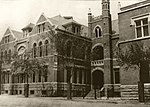Oregon Hill
Federal architecture in VirginiaHills of Richmond, VirginiaHistoric districts on the National Register of Historic Places in VirginiaNRHP infobox with nocatNational Register of Historic Places in Richmond, Virginia ... and 3 more
Neighborhoods in Richmond, VirginiaVictorian architecture in VirginiaWorking-class culture in the United States

Oregon Hill is a historic working-class neighborhood in Richmond, Virginia. Oregon Hill overlooks the James River and Belle Isle, and provides access to Hollywood Cemetery. Due to the neighborhood's proximity to the Monroe Park Campus of Virginia Commonwealth University, the neighborhood is sometimes referred to as a student quarter because of its high college student population.William Byrd III established a rural estate on the property in 1758. Wealthy heiress Grace Arents helped build many institutions to serve the community.
Excerpt from the Wikipedia article Oregon Hill (License: CC BY-SA 3.0, Authors, Images).Oregon Hill
South Laurel Street, Richmond Oregon Hill
Geographical coordinates (GPS) Address Nearby Places Show on map
Geographical coordinates (GPS)
| Latitude | Longitude |
|---|---|
| N 37.54 ° | E -77.451944444444 ° |
Address
South Laurel Street 408
23220 Richmond, Oregon Hill
Virginia, United States
Open on Google Maps








